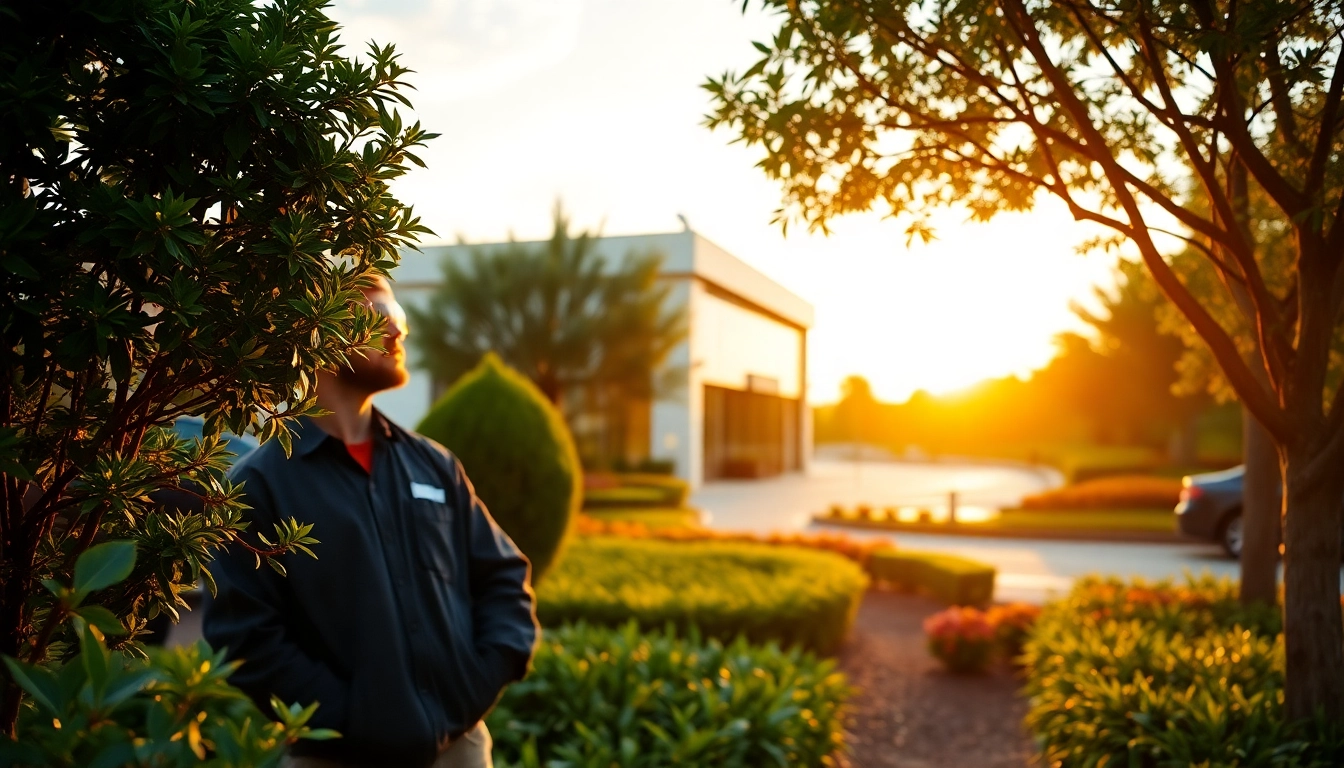Understanding the Importance of Commercial Landscaping
In today’s highly competitive business environment, first impressions matter more than ever. The appearance of a commercial property plays a pivotal role in attracting customers, retaining employees, and fostering an overall positive brand image. Consequently, numerous businesses are investing in professional landscaping services to enhance their outdoor environments. Engaging commercial landscaping contractors can not only boost aesthetics but also create functional, sustainable landscapes that provide numerous benefits.
Benefits of Professional Landscaping for Businesses
The advantages of investing in professional landscaping are vast. Here are some key benefits:
- Increased Property Value: Well-maintained landscapes can significantly elevate a property’s market value. Properties with attractive landscaping are often valued higher than those without.
- Enhanced Brand Image: A professionally landscaped property creates a positive impression on clients and customers, enhancing the brand’s image and identity.
- Employee Satisfaction: A nice outdoor landscape can elevate employee morale and satisfaction, leading to improved productivity and retention rates.
- Environmental Benefits: Landscaping contributes positively to the environment by providing habitats for wildlife, reducing heat through shade, and improving air quality.
- Cost Efficiency: Strategic landscaping can lead to reduced energy costs by providing shade, thus lowering air conditioning needs in hot months.
Environmental Impact of Commercial Landscaping
Commercial landscaping can play an essential role in environmental stewardship. The right landscape design not only beautifies a property but also promotes sustainability. Here are a few ways it contributes:
- Biodiversity Enhancement: By incorporating native plants and creating habitats, landscaping can increase local biodiversity.
- Stormwater Management: Strategic landscaping mitigates flooding and water pollution through rain gardens, permeable paving, and water-efficient irrigation systems.
- Carbon Footprint Reduction: Trees and plants absorb carbon dioxide, helping businesses lower their overall carbon emissions.
- Improved Urban Heat Island Effect: Thoughtful landscaping can reduce the urban heat effect, mitigating rising temperatures in built-up areas.
Enhancing Curb Appeal with Landscapers
Curb appeal plays a crucial role in attracting potential customers and clients. Professional landscapers bring expertise in creating visually stunning entrances and outdoor spaces.
- Design Principles: Knowledge of color theory, plant selection, and spatial design allows landscapers to create harmonious looks.
- Seasonal Interest: Incorporating plants that provide interest across seasons ensures the landscape is appealing year-round.
- Functional Spaces: Landscapers can design outdoor spaces that serve functional purposes, such as outdoor seating areas, walking paths, and green roofs, which can further enhance the curb appeal.
Choosing the Right Commercial Landscaping Contractors
Selecting the correct landscaping contractor is crucial to maximizing these benefits. Here are some tips on what to consider:
Key Qualities to Look For
A successful partnership with a landscaping contractor begins with identifying their key qualities:
- Experience and Expertise: Look for contractors with ample experience in commercial landscaping, specifically with projects similar to yours.
- Understanding of Sustainability: Ensure that the contractor values sustainable practices and is knowledgeable about eco-friendly landscaping materials and techniques.
- Licensing and Insurance: Verify that the contractor holds all necessary licenses and insurance to operate legally and protect you from liability.
- Communication Skills: Choose a contractor who communicates clearly and effectively, ensuring that all your needs and preferences are heard and prioritized.
Questions to Ask Potential Contractors
When interviewing potential contractors, consider asking the following questions:
- Can you provide references from past clients?
- What is your project timeline from start to finish?
- What are your methods for project management and quality control?
- How do you handle unexpected challenges during landscaping projects?
- Can you provide an itemized quote of costs involved?
Assessing Contractor Portfolios and Reviews
Examining the portfolios and reviews of potential contractors provides valuable insights into their capabilities:
- Portfolio Examination: Look for diversity in their past projects. Different design styles and post-completion photos can indicate the contractor’s versatility.
- Online Reviews: Websites such as Yelp or Google My Business can offer honest feedback from previous clients. Pay attention to both positive and negative reviews to understand their strengths and weaknesses.
- Case Studies: Ask for case studies or specific examples of how they handled challenges or executed a particular project.
The Process of Commercial Landscaping Projects
The process of commercial landscaping typically involves several key stages that ensure successful execution and outcomes:
Initial Consultation and Site Assessment
The initial consultation is crucial to understanding the client’s goals, vision, and budget. During this stage:
- The contractor conducts a thorough site assessment to evaluate current conditions, topography, sunlight exposure, and soil quality.
- Gathering client needs ensures that the final landscape design aligns with their expectations and functional requirements.
Designing Your Landscape Plan
Once the initial consultation is complete, the contractor will develop a detailed landscape design plan, which includes:
- Visual Concepts: The use of sketches or 3D models can help clients visualize the final product.
- Plant Selection: A well-informed plant selection process considers factors like climate, soil conditions, and maintenance requirements.
- Implementation Plan: An effective landscaping design should include timelines and milestones for different phases of the project.
Implementation and Maintenance Plans
Effective implementation of the project is critical. This phase covers:
- Execution: The contractor oversees all aspects of installation, ensuring that work is completed on time and within budget.
- Maintenance Plans: After project completion, maintenance plans ensure the longevity and health of the landscape, including irrigation, pest management, and seasonal clean-ups.
Innovative Trends in Commercial Landscaping
As commercial landscaping evolves, several innovative trends are shaping the industry and providing new opportunities for businesses:
Eco-Friendly Landscaping Solutions
There is a growing demand for sustainable landscaping practices. Eco-friendly solutions include:
- Native Plants: Utilizing native plants reduces water usage and the need for pesticides, supporting local biodiversity.
- Rain Gardens: These landscaped depressions are designed to capture rainwater runoff, reducing flooding and promoting water quality.
- Garden Roofs: Green roofs not only provide insulation but also mitigate urban heat and create habitats for wildlife.
Technology Integration in Landscaping Services
Technological advancements are paving the way for more efficient landscaping practices:
- Drone Surveying: Drones provide aerial views of the site, assisting in precise planning and design.
- Smart Irrigation Systems: Sensors within irrigation systems help optimize water consumption based on plant needs and environmental conditions.
- Digital Design Tools: Using software tools allows for virtual design walkthroughs, making the design process more interactive and client-friendly.
Community-Focused Landscaping Initiatives
Many companies are now embracing community-focused landscaping efforts, such as:
- Community Gardens: Partnering with local organizations to create communal green spaces promotes engagement and localized fresh produce.
- Pollinator Landscapes: Businesses are incorporating plants that attract pollinators, supporting local ecosystems.
- Green Education Programs: Educating the community on sustainable practices fosters a culture of environmental responsibility.
Measuring the Success of Your Commercial Landscaping
To determine the effectiveness of your landscaping investment, it’s essential to measure its success through various metrics:
Tracking ROI on Landscaping Investments
Calculating ROI can allow businesses to see the financial return on their landscaping investments:
- Value Appreciation: Measure property value before and after landscaping improvements.
- Increased Business Revenue: Analyze sales data from the time improvements were made to see if there is a correlation with increased foot traffic.
- Cost Reduction: Assess savings from reduced maintenance and energy costs due to improved landscaping.
Gathering Client Feedback and Performance Metrics
Client satisfaction and feedback can provide a wealth of valuable information that can indicate success:
- Surveys: Conduct surveys to gather clients’ thoughts on the aesthetics and functionality of the new landscape.
- Customer Foot Traffic: Analyze changes in the number of visitors to the property as a direct result of landscaping enhancements.
- Social Media Engagement: Monitor social media sentiments and engagement levels related to the property’s appearance.
Long-Term Maintenance and Improvements
Long-term success in commercial landscaping relies on regular maintenance and continuous improvements. Steps to consider include:
- Scheduled Maintenance: Establish a regular maintenance schedule to ensure the landscape remains healthy and attractive over time.
- Updating Your Landscape: As trends evolve, consider periodic updates or enhancements to ensure the landscape continues to meet the needs of the business and community.
- Training Staff: Educate staff on basic landscape care to maintain the property’s aesthetics between professional maintenance visits.



